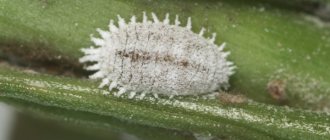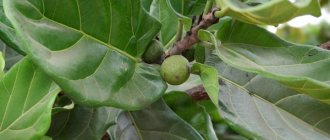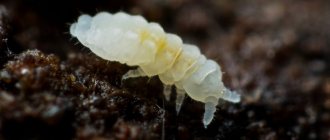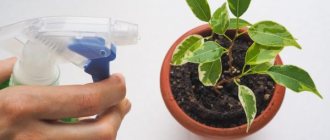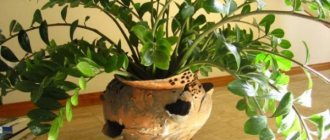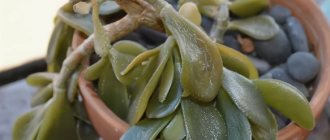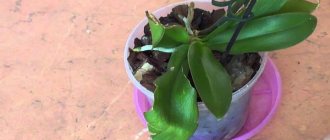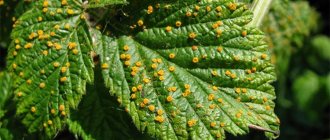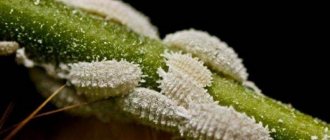Crassula, Crassula, or simply the money tree, as it is popularly called, has taken its rightful place among the plants that have become a real decoration for apartments and offices.
Its dark green color, the shine of its almost plastic leaves and its thick but small trunk have turned it into a favorite ornamental tree.
And it’s a shame if such beauty begins to lose its bright appearance, which, by the way, happens quite rarely.
White, small dots on the leaves - what is this: a manifestation of a disease or improper care? Let's solve this problem together!
Why is there a white coating and sticky spots on my Money Tree?
White spots and plaque on Money Tree (Crassula Ovata) are a common problem and can ruin the appearance of the most beautiful plant.
Luckily, identifying the causes and treating this problem is easier than you think. The main reasons for the appearance of a white coating on the leaves of Crassula can be mold such as powdery mildew, excess salt secretion or insect infestation. Our guide will help restore your flower to health and optimal appearance. Read more about this below.
Mosaic leaf color
White spots may alternate more or less evenly with normal green spots. In cucumber, this effect is caused by the white mosaic virus. The first signs are found on young leaves, often along the veins. First, small spots appear with a slight yellowish or greenish tint.
Then they grow, merge, and the entire leaf becomes greenish-white or yellowish. This disease often occurs at the same time as green mosaic virus, so light green and yellow can coexist with white spots.
In peas with deforming mosaic virus, thin oblong grains appear along the leaf veins. At first they are yellowish, then turn white and can become almost transparent. Sometimes there are light green areas between the veins.
Reasons for the appearance of white-silver dots on Crassula leaves
There are only three main reasons for the appearance of a white or silvery coating on the leaves of a plant: powdery mildew or ashtray, excess salts in the water, and insect infestation. Very rarely, the plant may secrete epicuticular wax (a natural barrier against sunlight). But this happens extremely rarely.
What to do with powdery mildew
Powdery mildew is a common cause of white spots. This white mold is a fungal disease that usually affects indoor plants. When this fungus infects a plant, it forms small white round spots on wide parts of the flower.
In Crassula, these spots appear on the leaves. In later stages, powdery mildew can be identified by fuzzy fungal threads that spread along the stems. The growth of powdery mildew is favored by low light and temperature, poor air circulation, and high humidity.
If powdery mildew can be identified at an early stage, treatment is quite easy. Simply spray the leaves with a solution of one tablespoon of baking soda, one teaspoon of homemade soap and 3-4 liters of water. Use it daily until the white spots disappear.
Excess salts: what is it and how to get rid of it
The money tree is a succulent that stores most of its water in its fleshy leaves. If you water your plant with water that has a high salt content, it can cause those unfortunate white spots or plaque to appear.
Crassula tries to restore the balance of salt content in the leaves, so it removes them through the pores. Unfortunately, such a coating is very similar to the initial stage of the appearance of powdery mildew. Watering from above can also cause stains on the leaves of the flower: the water evaporates and simply leaves salts on the leaves.
The easiest way to determine what you are dealing with is to wipe the leaves with a damp cloth and wait a week . If the spots reappear and look like fuzzy fungus, it is most likely powdery mildew. Salts cannot be released so quickly.
How to fight and how to treat Crassula infestation with insects
Insect infestation causes Money Tree chlorosis. Chlorosis occurs when a plant does not produce chlorophyll correctly and leaves begin to lose color and fall off. Mealybugs and spider mites can cause this (it is important to consider the differences in methods of controlling these pests).
What to do if mealybugs appear that look like cotton wool
Mealybugs are one of the most common insects that attack Crassula. You can identify them by their appearance (small flat white bugs). Usually they try to hide in the folds of the plant.
A popular remedy against scale insects is a cotton pad treated with alcohol. Just wipe the areas where bugs and their eggs accumulate. A preventative measure involves spraying a mixture of alcohol and water directly onto the bush every day for one month.
How to treat spider mites on Crassula
Spider mites are small red spiders that burrow into the soil. You can identify them by the white spots on your leaves. In later stages, cobwebs are visible on the leaves and stem of the flower. If left untreated, this will eventually kill the plant.
To determine if spider mites are causing the problem, simply shake the plant over the paper and look for red dots on the paper. If you find them, start treating the plant with alcohol once every three days for a month. This will kill the ticks and their eggs.
Less common pests
Aphids and thrips can also cause white spots to appear on Crassula. You can fight them in the same ways - just spray the flower with a mixture of water and alcohol. Keep doing this until the problem goes away.
Downy mildew (peronosporosis) on roses
In addition to powdery mildew itself, gardeners growing roses may also encounter so-called downy mildew, which is caused by completely different fungi. This disease is scientifically called downy mildew and appears as discolored spots (yellowish, red-brown or purple) on the upper side of the leaves. At the same time, brownish-grayish spots with a powdery coating may form on their lower side. Then a yellow border appears at the spots, after which the leaves darken, dry out and fall off. Usually, downy mildew damage to a rose starts from the top of the bush.
Among roses, flowers of hybrid tea varieties are most susceptible to downy mildew. Among the ornamental plants at risk are gloxinia, carnation, viola, forget-me-not, zinnia, chrysanthemum, hydrangea, etc.
Fungal spores of the pathogen overwinter in plant debris and soil. And in spring, summer and autumn, spores are helped to spread by wind, heavy dew, precipitation, insects, as well as contaminated garden tools. The most favorable conditions for the development of peronosporosis are cool, damp weather with drizzling rains, as well as heavy acidic soils.
Prevention and treatment of downy mildew are identical to those in the case of rose disease with powdery mildew (see above).
Proper agricultural technology and timely preventive measures are important conditions in the fight against powdery mildew of roses. Do not forget to give your plants enough time so that they delight you with lush blooms year after year.
Preventing the problem with proper care
If you see white spots on your Money Tree and can determine the cause, your flower is one step closer to health! But to prevent the problem from recurring, it is important to properly care and maintain your Succulent.
Lighting
Crassula needs at least 4 hours of bright sunlight every day. If this is not ensured, the plant will begin to stretch and become susceptible to pests. Low light also stimulates the growth of powdery mildew. So place your flower on a south-facing windowsill.
Watering
Always make sure the soil surface is dry before watering again. Crassula plants require less moisture than traditional houseplants. In addition, reducing the amount of moisture in the soil interferes with the development and growth of fungi. Proper watering is one of the most difficult and important skills when caring for indoor plants.
Temperature
Make sure you provide enough bright light for your flower, avoid excessive humidity and make sure the room temperature is maintained between 18-24°C. This will avoid the appearance of white coating on the leaves and grow a healthy tree. Make sure that the conditions for keeping the Money Tree match those that suit the flower.
Silvery dots on the leaves and other parts of the Crassula: what is it and why does it appear?
Crassula rarely gets sick, but sometimes gardeners are bothered by the white coating that appears on the leaves and trunk. Diseases in Crassula can appear due to improper care or insect pests.
- Incorrect watering. White spots on the money tree indicate improper watering. The plant does not like excessive moisture. The roots of the succulent may begin to rot, in which case it will be much more difficult to save it (why do the roots rot and what to do in this case?).
- Mealybug. If you notice a white coating on the axils of the leaves or on the roots that looks more like cotton wool, this indicates that a mealybug has settled on your Crassula. This parasite slows down the growth of the plant and bends the shoots. Because of it, the leaves begin to fall.
- Spider mite. The appearance of spider mites is indicated by white-yellow spots on the leaves. If you miss treatment at this stage, this will lead to the appearance of cobwebs and parasites on the plant.
- Fusarium rot. The disease in the money tree is difficult to notice when the trunk and leaves have not lost their elasticity. If you find a white coating, try rubbing it gently with your fingers. If you smell mold, it means the succulent is affected by Fusarium rot.
Hard water
After spraying leaves with hard water, white marks remain on them. It is simply a surface coating that washes off easily and poses little risk to plants.
However, if they are watered with such water for a long time, excess minerals will accumulate in the soil, and this can have a negative impact on the plants. If possible, it is better to water them with rain or filtered water.
Crassula treatment: how to get rid of the problem?
If the fat plant is covered with a silvery coating, it is important to take timely measures to save the plant, and what exactly needs to be done is described below.
If watering was incorrect
Crassula needs rare but abundant watering, as it retains moisture. In summer, the plant should be watered 1-2 times a week, in winter – once every two weeks. Water the Crassula with water at room temperature. Pay attention to the location of the plant in your home (office). The succulent loves indirect sunlight.
What to do if you have mealybugs?
A soap solution will help deal with mealybugs. If you find only a white coating in the form of fluff, then treat the plant with cotton swabs. Repeat this procedure several times. If there are parasites on the affected areas, you can fight them with the help of insecticides:
Ventilate the room: Crassula’s immunity will be strong.
If you have spider mites
Spider mites do not like high humidity. You need to give the plant a warm shower, treat it with a soap solution, a solution of garlic or tobacco, cover it with a cap and create a greenhouse. Biological products such as:
After a week, repeat the procedure. Inspect other plants (if present) for harmful residents to prevent them from appearing again.
For fusarium rot
Fungicides cope with fusarium rot: “Fundazol” and “Fungicide”. It is necessary to transplant the succulent into a new pot.
- It is necessary to remove all the old soil, as traces of the disease may remain on it, and inspect the roots.
- If some of them have begun to rot, then they should be removed with sterile scissors.
- Dip healthy roots into a solution of potassium permanganate for a while.
- To make the plant take root faster, soak it in a root formation stimulator.
Despite its unpretentiousness, the money tree is susceptible to diseases. If you notice the disease in time and start fighting it, Crassula can be saved. With proper and competent care, you can extend the life of your plant for a long time.
Improper care
First of all, you should consider the negative factors that relate to errors in plant maintenance. It is they that in most cases lead to a deterioration in the appearance of the fat plant, falling or blackening of foliage, disproportionate growth, etc.
Yellowing and falling leaves
Very often, owners of fat cats face this problem. In this case, to eliminate the problem, it is important to adhere to the following watering rules:
- Moisten the soil only with warm water, previously filtered or settled. When watering with cold water, the difference in air and soil temperatures can adversely affect the condition of the plant.
- Avoid excessive waterlogging of the soil during the cold season. This situation leads to rotting of the roots, as well as the formation of fungus.
- Dying of leaves can be caused by drying out of the soil in summer. If its top layer becomes too hard, you should immediately water the flower.
- prolonged exposure to direct sun;
- lack of sufficient fresh air flow;
- lack of nutrients in the soil.
Stretching the stem
Disproportional development of the bush often occurs due to insufficient lighting. If watering standards are observed, but there is a lack of sunlight, the fat plant stretches the stems, trying to get to the sun. As a result, there is insufficient development of leaves and branches, despite their large growth.
If the money tree is sick for this reason, just put it closer to the window. However, it is important to avoid excessive exposure to sunlight to prevent burns.
In some cases, the stems become elongated due to the normal development of the crassula. To prevent them from falling on their side, you should transplant the flower into a wide pot. Its root system grows in a horizontal plane, so transplanting it into a deeper container will not give the expected results.
soft leaves
If the foliage of the money tree has lost its elasticity and softened, then this could be caused by excessive watering, lack of lighting or inappropriate room temperature. The process of restoring the flower should be started immediately, otherwise it will soon die completely.
The plant is removed from the pot along with a lump of earth, then the soil is removed. The root system is being inspected.
Note!
If rotting or moldy areas are found, they are cut off. Next, the roots are washed under a stream of water at room temperature, the sections are treated with charcoal or activated carbon tablets crushed to powder.
All that remains is to plant the fat plant in a pot using a new substrate. For the first watering, carbendazim is used. The plant is placed in a bright place, but without direct sunlight.
There is no point in saving Crassula if rotting of the roots occurs at the base, or they are soft and dark along their entire length.
Leaves turn black
If the leaves of the money tree become covered with black spots, this is an indication of sunburn. The unhealthy area appears strictly at the point where the light ray hits and does not spread further. The blackened leaf can be removed, and care must also be taken to prevent direct sunlight from hitting the flower in the future.
However, there is another reason for the formation of black spots on the leaves of the fat plant - fungal infection. The fight against this disease consists of using the drug Fitosporin-M. It is diluted in a twice as large volume of water, after which it is thoroughly stirred and diluted again with water (the procedure will be described in more detail in the instructions for the drug). The foliage is sprayed with the resulting solution, and after a while the operation is repeated.
Lack of growth, drying out
Crassula will stop growing if its roots become crowded in the pot. You should choose a container that is slightly larger in volume. The new pot should be wider and only slightly higher, since the roots prefer to grow horizontally. It is better to transplant a flower in the spring, but if it is infected with fungus or other diseases, the procedure cannot be postponed.
A slowdown in development can also occur during winter dormancy. This is a normal phenomenon and does not require any measures to be taken.
Another reason could be a lack of nutrients in the soil or poor lighting. It is necessary to purchase complex fertilizers in a specialized store and use them in accordance with the instructions.
Important!
Drying foliage indicates an incorrect watering regime. Excessive or insufficient amounts of moisture may be added to the root. In summer, watering is carried out more often, after the top layer of soil dries, in winter - less often.
White dots on leaves
The money tree can be overly saturated with moisture received not only from the ground, but also from the air. As a result, the plant has to open spores on the leaf blades to get rid of excess water.
The appearance of white spots does not promise any particular danger, however, you should pay attention to the frequency of watering and, if possible, reduce the humidity in the room (for example, increase the temperature with a heater if we are talking about the winter period).
Reddening of foliage
A change in leaf color from green to pale or even bright red can occur for three reasons:
Treatment will be appropriate:
- Provide the plant with shade.
- Ventilate the room regularly.
- Fertilize with nutrients. The need for this action is also indicated by wilting leaves.
Dark (brown) spots on tomatoes - black bacterial spot
The spots do not merge into large and dark ones, as with late blight, but rather look like a black rash. Symptoms of black bacterial spot of tomatoes.
Initially, small spots of olive color appear on the leaves, oily in appearance, only about 1-2 mm in diameter. Quite quickly they darken and spread, covering all larger parts of the leaf and stems.
All above-ground parts of the plant are affected: leaf petioles, sepals, stalks, tomatoes and peppers. As the fruits grow, spots also appear on them, their number increases, by this time the stems and leaves seem to be covered with scabs. Due to malnutrition, the fruits do not ripen, and the leaves gradually dry out and fall off. Yield losses can be 90-100% - rotting of the fruit tissue occurs under the spots. Loss of leaf mass from 50 to 100%.
Treatment with chemicals is carried out with copper-containing fungicides - spraying with a 1% solution of Bordeaux mixture, preparations Hom, Oxychom, Ordan, etc.
Among the biological preparations, the drug Fitolavin is very effective on tomatoes - it helps to treat not only bacterial black spot, but also bacterial cancer, tomato blossom end rot and other nightshade diseases
Diseases
All Crassula diseases are a consequence of fungal or bacterial infection. Favorable conditions for their spread are dampness and cold air. Let's take a closer look at money tree diseases and their treatment with photo examples depending on the type of lesion.
Fungal diseases
Most often, infection by fungal spores occurs during cold weather, when there is increased air humidity in a poorly heated room. Wet or gray rot appears as brown spots, gradually increasing in diameter and covering the entire leaf.
Brown (brown) spots of tomatoes - late blight
Brown spots appear on the lower leaves of the tomato, then throughout the plant. Unripe fruits turn brown. In cold weather, a whitish-gray coating appears along the edges of the spots on the leaves. With increased humidity, damaged leaf tissue softens. These signs also signal that the tomato bush is infected with late blight. Spots on tomato leaves and what to do? See here
Pests
In addition to Crassula diseases, pests also have a negative impact, photos of which will be presented below. These include spider mites, scale insects, mealybugs and rootbugs. The method of combating each type of insect is different and therefore requires separate consideration.
Shchitovka
This pest is quite large in size, so it is clearly visible to the naked eye. Females remain motionless, they are attached to a stem or leaf, covering their body with some kind of shield. The scale insect has a light brown or brown color.
The first step in the fight against the pest is its manual removal from the surface of the fat plant. Next, treatment is carried out with a soap solution or a commercial preparation called Fitoverm. To consolidate the result, spraying is repeated after a few weeks.
Spider mite
Unlike scale insects, Crassula is practically invisible on the surface. The appearance of a tick is determined only by the corresponding sign - a silvery coating on the money tree, which is actually a very thin cobweb covering its habitat. The pest itself looks like a gray or red dot continuously moving around the plant.
Along with the cobweb, a change in the appearance of the leaf plate occurs. It becomes covered with brown spots, turns yellow and falls off over time. A simple method of eliminating the mite is to spray the crassula and then wrap the pot in a plastic bag. This will sharply raise the humidity level, and in such conditions the pest does not live long.
Soap solution or preparations Apollo, Actellik, Fitoverm are also effective in removing insects.
Mealybug
The insect quite often attacks Crassula. Its habitat is the axils of the leaves, in which the juice is sucked and plant tissue is eaten. As a result, the immunity of the fat plant weakens, accompanied by the fall of leaves. Externally, the pest’s activity manifests itself as a powdery discharge resembling cotton wool.
You can remove the insect with a stream of water. The affected areas are wiped with a cotton swab dipped in garlic infusion or alcohol solution. In advanced cases, the drugs mentioned above are used.
Root mealybug
Some manifestations of money tree diseases are caused by root worms, which are very difficult to detect. It will be possible to identify the cause of the deterioration of the flower only during the process of replanting - growths and movement of insects with a white body will be noticeable on the roots.
The pest is removed under running water at a temperature of 50 degrees. After this, the roots are treated twice in a Fufanon or Actellik solution with an interval of 7 days.
